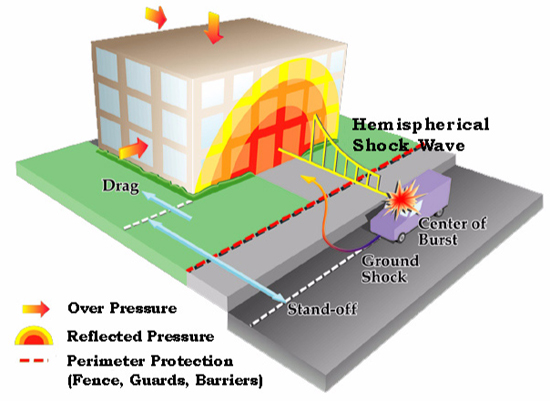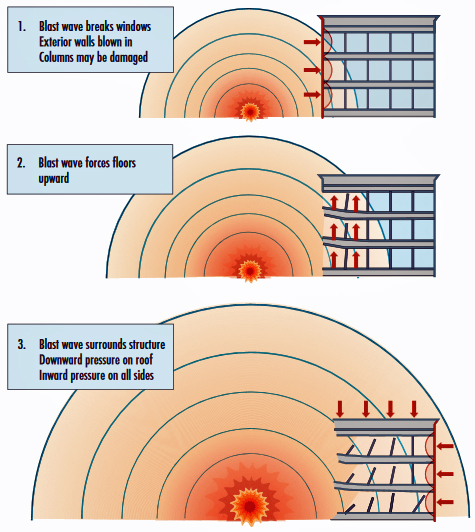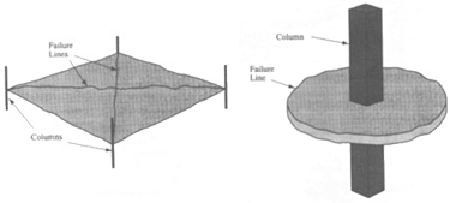Designing for Blast
Table of Contents
Introduction
Purpose
Threat
For terrorist activities, usually the two main considerations are for vehicles and weapons [2]. In terms of watching out for vehicles, the potential threat emerges from all sides of a building that is parallel to or facing a street. The vehicle is considered an air-blast load and decreases with distance so the primary danger is near the base of the building. For prevention of vehicle attacks apart from screening are intrusions such as anti-ram barriers along the perimeter of the building as well as utilizing the form of the landscape to create an obstacle course can be effective. However, oftentimes the vehicle itself is not the only threat because they can be used as a diversion or container for a secondary attack such as an explosive or hand-held weapons like a gun so further protection is needed.
There are a multitude of various weapons that produce a hazard to the lives of people but in regards to a building, the greatest pressure comes from explosives. Factors to be aware of are that the impact of explosives decrease very quickly with time and space and usually the pressure produced increases linearly with the size. Although the actual explosion only lasts a couple milliseconds, the area of the shock wave can hit the entire building and even the surroundings.
Effects of an Explosion:
- The side of the building facing the initial source can be amplified up to ten times the pressure
- Has a positive pressure phase and a negative pressure phase
- During the negative pressure phase, regions with low pressure such as windows and sloped roofs fail and collapse
- Thin members like columns are impacted more by drag effects than direct pressure
- Rebound refers to structures moving in the reverse direction due to vibration and can cause the exterior envelope to fall
- Below the point of impact, an underground crater will form that damages the foundation and anything below grade
- Any energy of the weapon that transfers through soil will create a small earthquake that can derange mechanical and electrical systems
Vehicle weapon threat [2] |
|---|
Sequence of Air-blast Effects [2] |
|---|
Building Damage
Damage done to a building can be separated into two categories of direct air-blast and progressive collapse [2]. Direct air-blast refers to the source of the explosion and takes into account the damage caused by the high-intensity pressures near the incident. In some cases, this may cause the exterior envelope to collapse in a specific area. How severe the damage ends up being, is dependent on the weapon size, distance from the building envelope, and what materials it is made of.
After the initial failure in a localized area, the extent of the damage spreads out to further elements, called progressive collapse. This may propagate laterally outwards or even vertically upwards and downwards. Not all buildings face progressive collapse since this depends on the features of the building.
Design Criteria to Prevent Progressive Collapse:
- Indirect design: prescriptive design measures, two-way systems
- Direct load: design of individual structural members to take the load
- Alternate load path: Includes possibility of losing some members yet does not effect the stability of the building
Structural Aspects and Specifications
Ground
Windows/Fenestration
- Use either laminated glass or apply anti-shatter film to glazing [4]
- Frame around window should exceed capacity of glazing, known as "glass fail first criteria"
- Designed to first resist conventional loads, then for explosive loads/ balance [2]
- Typically the weakest part of a building, balanced design means it does not lose to frames and wall systems
- Minimize number and size of windows
- For new construction, use laminated annealed glass with structural sealant
- Glass can break and retained by frame or only falls within 3-10 feet from the frame
Table 1. Performance Conditions for Windows [2] | |||
|---|---|---|---|
| 1 | Safe | None | Glazing does not break. No visible damage to glazing or frame. |
| 2 | Very High | None | Glazing cracks but is retained by the frame. Dusting or very small fragments near sill or on floor acceptable. |
| 3a | High | Very Low | Glass cracks. Fragments enter space and land on floor no further than 1 meter (3.3 feet) from window. |
| 3b | High | Low | Glazing cracks. Fragments enter space and land on floor no further than 3 meters (10 feet) from the window. |
| 4 | Medium | Medium | Glazing cracks. Fragments enter space and land on floor and impact a vertical witness panel at a distance of no more than 3 m (10 feet) from the window at a height no greater than 2 feet above the floor. |
| 5 | Low | High | Glazing cracks and window system fails catastrophically. Fragments enter space impacting a vertical witness panel at a distance of no more than 3 meters (10 feet) from the window at a height greater than 0.6 meters (2 feet) above the floor. |
Structural Layout
Site
In terms of the site, it is more beneficial to place the building further from the property lines; both away from streets as well as neighboring buildings [2]. One way to do this is to design a plaza that sits in front of the building in question that also wraps around the sides and back. But in this case, the two sides and the back will be more vulnerable as well as considerations for the envelope below grade. There can also be careful planning of naturally occurring obstructions in the surroundings such as bollards, trees, and street furniture [1].
| Schematic Layout of Site for Protection Against Bombs [7] |
|---|
Architecture
The amount of damage to the structure also depends on the general shape [2]. Poor choices for the architecture would be reentrant corners and overhangs that have the potential to strengthen the air blast by containing the shock from the explosion. When necessary, it is better to include larger and more gradual reentrant corners or overhangs in comparison to short and sharp ones. For the exterior of the building, convex shapes, such as a circular building, are preferred over concave, like flat or u-shaped buildings. Also, arches and domes are more resilient to blast shock than cubicle forms [1]. In most cases, be aware that single-story buildings are safer than tall multi-story buildings. If terraces are considered, careful planning for framing and details are needed to minimize damage to beam supports [2]. Lobby and loading dock areas, which are frequently targeted in an attack and may portray progressive collapse should be planned so that they are exterior to the main section. Soil can be a great obstruction to shock waves such as utilizing beamed walls and buried roofs, but do not design parking overhead. In summary, less complicated geometric shapes should be the first option for design and unnecessary decoration should be avoided whenever possible.
Internal
The internal layout of the building should be arranged so that the section with the greatest 'value' is the most protected and therefore furthest away from the threat [1].
- Foyer areas surrounded with reinforced concrete walls
- Double doors and doors facing the corridor eccentrically
- Entrance should be separate from building and closely controlled
- No parking below building
Something else that has to be considered is that a fire could occur after the explosion and generate even more damage so all the members inside should be fire-resistant.
| Internal Planning of a Building [1] |
|---|
Bomb shelters are designated areas within a building that offer maximum protection to the inhabitants from a bombing. They should be designed large enough to fit all people inside the building and can be easily accessed at all times. The location is important and needs to be away from any openings such as doors and windows and unless the roof is strong, it should not be on the top floors. It is necessary for the walls to be fully concrete and not share the same space with parking, gas tanks, light curtain walls, conference rooms, and even bathrooms. A basement would be a good choice provided the building does not collapse on it.
- Accommodate everyone inside
- Easy communication with outside world
- Adequate sanitation/ventilation
- Blast pressure controlled to be lower than rupture pressure of the eardrum
- Alternate escape routes available
Issues and Considerations
- First, choose factors that will dictate the design [7]
- Designed for one particular bomb size and distance or multiple possible scenarios
- Consider conventionalized loading
- Type of structure; completely enclosed or open
- Decide a maximum for allowed response for corresponding conditions
- Can be elastic or deflect to the extreme or mix of both
- Considered for every part of the structure
- After choices are made, the yield-point resistance is computed
- Recognize there are always unpredictable factors; uncertainty up to 25%
- Blast pressure, duration, structural properties, and more
- Refining and editing calculations is super important and crucial to reduce uncertainty as much as possible
- After structure is completed, engineers should only perform accurate physical and pressure measurements during testing
Additional Reading and Resources
Contributors:
User Last Update Former user (Deleted) 1317 days ago Former user (Deleted) 1318 days ago Former user (Deleted) 1318 days ago







